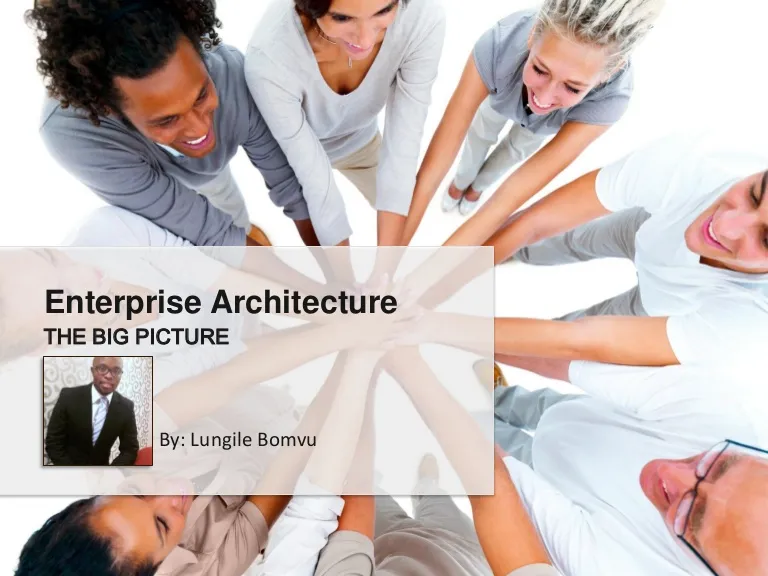Enterprise Architecture - The Big Picture
Transcript
THE BIG PICTURE
By: Lungile Bomvu
Enterprise Architecture
What is Enterprise Architecture?
Where does Solutions Architecture fit in?
How does TOGAF assist in EA initiatives?3
2
1
Typical IT Landscape of an Organization.
Problem Statement
× Too Large and Complicated.
– Systems, Processes, People, Information, Infrastructure,
External Systems, etc.
× Everything Impacts Everything.
× Too costly to maintain, improve or change.
× Too hard to add or remove business components.
× Difficult to adapt to strategic changes and keep up
with competition.
What is it anyway?
A process to achieve organizational
change.
The organization as a whole.
What does it entail?
Organizational effectiveness and
agility.
“Enterprise Architecture (EA) is a high level,
strategic technique designed to help senior
managers achieve business and organisational
change”. (TechWatch 2009).
Enterprise Architecture is the process that
translate business strategy into tangible
exectuable solutions by analyzing current
architecture state, designing a future state and
creating road maps to fill in the gaps.
2
What Is It?
Why the fuss?
3
1
What is it anyway?
A process to achieve organizational
change.
The organization as a whole.
What does it entail?
Organizational effectiveness and
agility.
The process holistically analyses:
• Business Architectures
• Information Systems Architectures
• Technology Architectures
Enterprise architecture describes how the
organisation’s information systems, processes,
organisational units and people work as a whole.
2
What Is It?
Why the fuss?
3
1
What is it anyway?
A process to achieve organizational
change.
The organization as a whole.
What does it entail?
Organizational effectiveness and
agility.
Enterprise Architecture is really the key to
achieving organisational effectiveness and agility.
Enterprise Architecture enables the ability for an
organization to grow and swiftly change as its
market evolves. Therefore gaining competitive
advantage.
2
What Is It?
Why the fuss?
3
1
The Enterprise Architect Role.
The enterprise architect is responsible for
implementing the CIO's vision and IT strategy
to support the business strategy.
Defining strategic programs, selecting the
appropriate technology platforms, and
providing standards and governance
mechanisms for strategic program
implementations.
They must acquire a holistic understanding of:
1. The Business and IT Strategy.
2. The organization and it’s operations
3. The latest technologies.
Strategy
TechnologyOrganization
The Solution Architect Role.
The solution architect is responsible for
implementing the different strategic
programs.
Defining the architectural solution for each
program, selecting the appropriate
technology platforms, handling intergroup
communication and technical decision
making during implementations.
Mediates between:
1. The Enterprise Architect.
2. The Business Teams.
3. The Technical Teams.
Enterprise
Architect
Business
Team
Technical
Team
Frameworks and Methodologies
The Open Group Architecture Framework (TOGAF)
Ministry of Defence Architecture Framework (MODAF)
Federal Enterprise Architecture Framework (FEAF)
BM’s Business Systems Planning (BSP)
Zachman’s Framework
Enterprise Architecture Planning (EAP)
Department of Defence Architecture Framework (DoDAF)
>
>
>
>
>
>
>
TOGAF 9.1 Diagram
TOGAF is as framwork, detailed
method and set of supporting tools
for developing an enterprise
architecture.
It comprises of:
• Architecture Development
Method (ADM)
• ADM Guidelines and Techniques
• Architecture Content
Framework.
• Enterprise Continuum and Tools
• TOGAF Reference Model
• Architecture Capability
Framework
With this framework and its toolsets
you can model your current
architectural landscape, model how
you would like it to look like, create
roadmaps for moving from AS-IS to
TO-BE and start implementing the
changes.
TOGAF 9.1 (The Open Group Architecture Framework)
ADM Summary
This is the core of TOGAF.
This method helps define:
• Vision, Goals and Drivers
• Business Processes,
Capabilities and Functions
• Data Models and Business
Applications
• Technology and Infrastructure
Requirements
• Analysis of opportunities and
designs of solutions
• Migration plans
• EA Governance Policies
• Change Management
Processes
• All requirements and changes
aligned to the vision
Architecture Development Method (ADM)
ADM G&T Summary
Users Manual, Guidelines and
Techniques for using the ADM
Explains types of inputs,
process and output for each
phase.
Includes:
• Input Templates
• Deliverable Contracts
• Iteration Techniques
• Architecture Principles
• Architecture Patterns
• etc…
ADM Guidelines and Techniques
Content Framework Summary
Provides a detailed model of
architectural work products.
States what type of
deliverables, artefacts and
building blocks are produced
at each ADM phase.
Helps create Unified and
consistent content modelling
framework.
Provides a comprehensive
checklist of outputs.
Architecture Content Framework (ACF)
Playbook containing different
established architectures and
solutions.
Virtual Repository for:
• Industry Specific
Architecture Models
• Architecture Patterns
• Architecture Descriptions
• Architecture Assets
Consists of:
• Architecture Continuum
• Solutions Continuum
Helps organisations to adapt
reusable architectures and
solutions.
Enterprise Continuum
Enterprise Continuum Summary
TRM Summary
A repository of technical (IT
Specific) templates and
standards which can
referenced across your
enterprise architecture.
TOGAF consists of two models:
• Technical Reference Model
(TRM)
• Information, Integration,
Infrastructure Reference
Model (III-RM)
Reference Models
III-RM Diagram
A repository of technical (IT
Specific) templates and
standards which can
referenced to across your
enterprise architecture.
TOGAF consists of two models:
• Technical Reference Model
(TRM)
• Information, Integration,
Infrastructure Reference
Model (III-RM)
Reference Models
Describes the appropriate…
• Organizational Structures
• Processes
• Roles and Responsibilities
• Skills
…required to create and to
operate a successful enterprise
architecture.
This includes:
• Architecture Board
• Architecture Compliance
• Architecture Contracts
• Architecture Governance
• Architecture Maturity Models
• Architecture Skills Framework
Enterprice Capability Framework
Capability Framework Diagram
Holistic Simplified Architectural View.
– Systems, Processes, People, Information, Infrastructure,
External Systems, etc.
Simplified Impact Analysis.
Simplified ability to change your IT Landscape.
– To one that is simpler, loosely coupled, and is cost effective.
Increased business change flexibility and growth
opportunities.
Easier to adapt strategic change and establish competitive
advantage by being agile to changing market environments.
Agility Scalability Effectiveness
THANK YOU!
